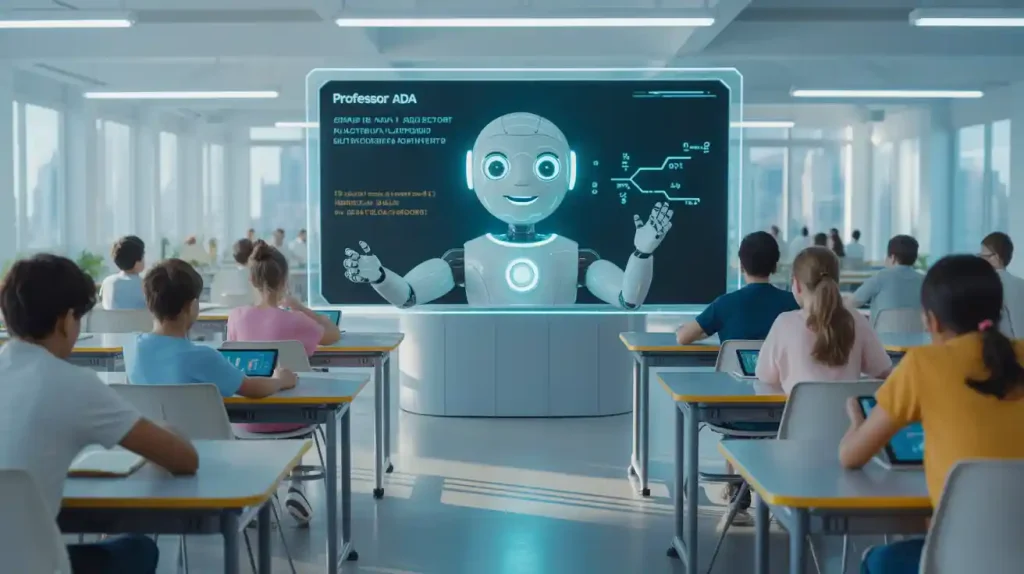
Introduction:
The education sector is changing — fast. Artificial Intelligence (AI) has gone from being a futuristic concept to a real tool in classrooms today. But with this leap in technology comes a big question: Are AI tutors in education a revolutionary tool for learning or a risky shortcut that could harm education in the long run? This article dives deep into both sides of the debate.
What Are AI Tutors?
AI tutors in education are intelligent programs or platforms that provide educational support to students through adaptive algorithms. Think of them as super-smart digital assistants that understand a student’s learning pace, strengths, and weaknesses — and adjust lessons accordingly.
Examples of AI Tutors:
Khanmigo (by Khan Academy)
Duolingo’s AI chatbot
Socratic by Google
Carnegie Learning
Squirrel AI (China)
The Promise of AI Tutors
Personalized Learning at Scale
AI tutors customize learning paths for each student. No two learners are the same, and with AI, lessons can be tailored to individual needs, helping slow learners catch up and fast learners move ahead.
24/7 Availability and Instant Feedback
Unlike human tutors, AI doesn’t need sleep or breaks. Students can get help with homework at 10 PM or clarify a doubt at 6 AM — and the feedback is immediate.
Bridging Educational Gaps
In underserved areas where teachers are few, AI can step in to ensure students still receive quality education. It democratizes learning by providing equal access to resources.

How AI Tutors Are Being Used in Classrooms Today
Elementary Education
Apps like DreamBox and Osmo help kids grasp basic math and reading skills with fun, gamified learning — powered by AI that adjusts difficulty levels in real-time.
High School Implementation
Platforms like Quizlet or Google Classroom with AI features offer quiz generation, progress tracking, and adaptive test prep. Some schools even use AI tutors for coding or science help.
College and University Use Cases
AI is aiding in grading, plagiarism detection, and offering writing support through tools like Grammarly and Turnitin. In higher ed, AI tutors in education are often embedded in online course platforms for real-time assistance.

Advantages for Teachers and Institutions
Reduced Administrative Workload
AI can automate grading, attendance tracking, and even generate lesson plans. That means teachers spend more time teaching and less time on paperwork.
Enhanced Classroom Engagement
AI-powered games and interactive simulations bring subjects like history or science to life. Students are more likely to pay attention when the lesson feels like a video game.
Data-Driven Insights for Improvement
AI analyzes performance data and suggests improvements. Teachers can identify struggling students early and adjust their teaching strategy.
The Risks of AI Tutors in Education
Over-Reliance on Technology
Just because AI is available doesn’t mean it should be the only learning tool. Relying too much on machines may dull critical thinking or problem-solving skills in students.
Data Privacy and Security Concerns
AI tutors in education collect a lot of data — student performance, behavior, even voice recordings. Who owns this data? Can it be hacked? These are serious concerns for parents and schools alike.
Job Displacement of Human Educators
There’s fear that AI will eventually take over teaching jobs. While AI can assist, it cannot replicate human intuition, care, and adaptability in complex situations.
Bias and Inaccuracy in AI Algorithms
AI is only as good as its programming. If the data it’s trained on is biased or limited, it could reinforce stereotypes or give incorrect feedback.
Student Perspective
Motivation and Mental Health
Some students thrive with digital tools, but others may feel disconnected or pressured by always-on learning systems. Human encouragement still matters a lot.
Accessibility vs. Isolation
While AI can help students learn from anywhere, it can also lead to social isolation. Learning is not just academic — it’s also emotional and social.
The Role of Human Teachers
Emotional Intelligence and Empathy
A human teacher can sense when a student is sad, anxious, or distracted — and respond with kindness or guidance. AI can’t replicate that emotional touch.
Managing Classroom Dynamics
Handling group projects, class disputes, or creative discussions? That’s still a human domain. Teachers are irreplaceable when it comes to managing real-time interactions.
Ethical Considerations
Who Controls the AI?
Is it the school, the government, or private tech companies? The control and intent behind AI tutors must be transparent to prevent misuse.
Transparency and Accountability
If an AI gives wrong advice, who’s to blame? There needs to be clear accountability in how AI tools are built and monitored.
Government and Policy Involvement
Regulation of AI Tutor in Education
Governments must step in to create policies ensuring ethical use, data protection, and inclusivity in AI-powered classrooms.
Investment in Teacher-AI Collaboration
The future lies in hybrid models. Investments should focus on training teachers to work with AI — not against it.
The Future Outlook
AI as a Teaching Partner, Not a Replacement
The most balanced perspective sees AI not as a teacher replacement, but as a powerful assistant. Together, AI and teachers can create a more inclusive, efficient, and engaging classroom.
Preparing Future Generations for AI-Enhanced Learning
Students need digital literacy and critical thinking to navigate AI-rich environments. Schools must prepare them for a future where tech and humanity coexist.
Conclusion
AI tutors are here to stay — but whether they become a revolution or a risk depends on how we use them. The key is balance. Technology should amplify human efforts, not replace them. By combining the best of AI with the heart of human educators, we can unlock a future of smarter, fairer, and more engaging education.
FAQs
1. Is AI better than human tutors?
AI tutors are fast, scalable, and available 24/7 — but they lack the human touch, empathy, and real-time judgment that a teacher offers.
2. Can AI replace teachers?
Not entirely. AI can assist and enhance learning but can’t replace the role of human educators, especially in emotional and social development.
3. What skills do students need in an AI-supported classroom?
Digital literacy, critical thinking, and the ability to self-regulate learning are essential in AI-enhanced education systems.
4. How do AI tutors handle different learning styles?
They use adaptive algorithms to adjust pace, difficulty, and delivery style based on student interaction and performance data.
5. What should parents know about AI in education?
Parents should understand what data is being collected, how it’s used, and ensure that AI tools are supplementing — not replacing — their child’s overall learning experience.






No Comment